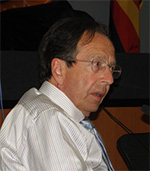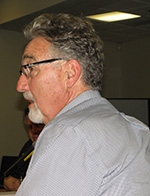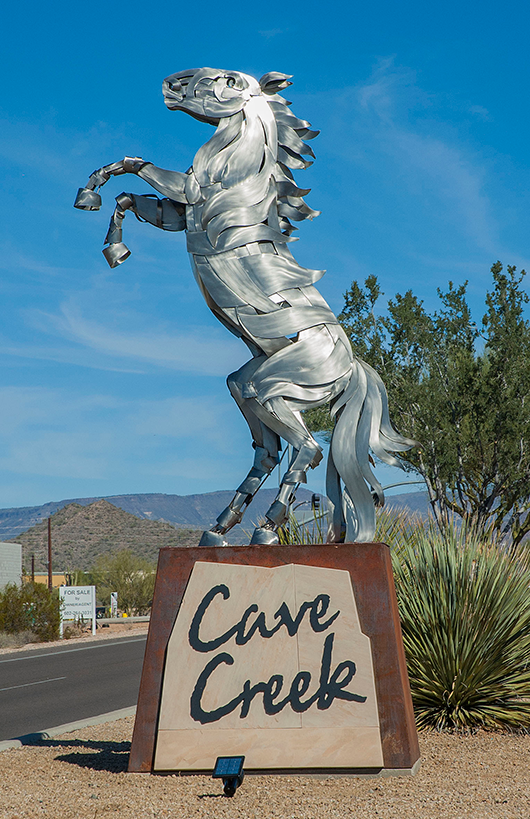CAVE CREEK – During Tuesday night’s Call to the Public, Carole Perry thanked the town on behalf of the Sonoran Arts League for removing all the barricades and opening traffic lanes during the Hidden in the Hills event.
Attorney Craig Simon spoke on behalf of the Roadhouse and Hideaway to let council know about an event coming up that weekend, which he said was a showcase for custom motorcycle builders.
 Craig Simon (l) and Mark Bradshaw
Craig Simon (l) and Mark Bradshaw
Simon said there would be a shuttle from the Roadhouse to the Hideaway and other businesses, such as Harold’s, agreed to allow for overflow parking during the event.
He said there would be no on-street parking and “everything should go smoothly.”
Later, answering questions, Hideaway and Roadhouse owner Mark Bradshaw seemed to surprise council when he said this was the 18th year he’s been hosting the event, adding it is a much smaller event than Bike Week.
Although Town Manager Peter Jankowski indicated both traffic lanes would be open in both directions through town during the event, Bradshaw said that wasn’t really possible because of the construction project and there are not two lanes available.
Based on advice received from Town Attorney Bill Sims during the executive session held before the public meeting, council voted unanimously to have him review the town’s ordinances, definitions and home occupation statutes as they pertain to issues that have arisen at 41355 N. Fleming Springs Road.
The property has been the subject of a long-time neighborhood feud over the use of the residential property for a commercial auto repair business.
 Mayor Vincent Francia
Mayor Vincent Francia
When Mayor Vincent Francia called for public comment, Kerry Smith said it was hard to comment without knowing what the options were and seemed backwards.
He said the concern was over the operation of a commercial business in a residential neighborhood and Smith recalled the last time the issue was before council there was supposed to be a mediation held between the owners and neighbors.
Smith said the issue hasn’t been resolved and instead they have added more vehicles to the property.
Francia advised Kerry in order for mediation to be successful both parties need to “sit at the table.”
However, he said that didn’t happen.
According to Francia, the issue has been festering for about five years, began in 2008 when the town allowed home occupations and has been an ongoing topic brought up during Office Hours with the Mayor and Vice Mayor.
Councilman Mark Lipsky advised citizens, “We take the issue very seriously and aim to get to a resolution that works.”
Councilman Thomas McGuire said revoking their home occupation permit was a start.
Councilman Dick Esser said the issue involves private property rights. However, promises the owners made to remove vehicles hasn’t happened.
Councilwoman Susan Clancy said, “The majority of us believe in private property rights,” and the town is seeking a solution that won’t have unintended consequences.
Councilman Ernie Bunch said the situation arose from a business becoming too successful, which, in turn, led to ignoring the conditions of their home occupation permit.
He said the issue was then exasperated by the neighbors and has become an unfortunate situation.
Council voted unanimously to take over administration of the median banner program from the Cave Creek Merchants and Events Association (CCMEA).
CCMEA Treasurer Marc Peagler said he was there to answer any questions about the program.
 Vice Mayor Steve LaMar
Vice Mayor Steve LaMar
As a follow up to a meeting held about 90 days earlier, Vice Mayor Steve LaMar said the appearance of the banners has not improved and the agreement currently in place does not address any of the issues raised.
Jankowski stated there were definitely quality issues with the banners.
Peagler told council he’s never liked the program, which was supposed to generate a revenue stream for CCMEA, and said, “It’s just not happening.”
He went on to say, “It’s an administrative nightmare for us.”
LaMar said, “We want to make sure our medians are a plus, not a minus,” indicating the program could be done away with altogether if staff finds it to be too big a burden.
Bunch said the intention of the program, and the only reason he voted for it, was to create revenue so CCMEA wouldn’t have to come to council every year for money.
Lipsky asked to have the four-day versus five-day work week placed on the agenda.
He said he understood why the four-day work week happened and when it happened but didn’t understand why it became permanent.
Francia said it was implemented in 2008 as a cost-saving measure but then staff preferred the four-day week and the community seems to have accepted it.
Just to be clear, when the town went on a four-day work week during the economic downturn in 2008, employees’ hours were cut from 40 to 32.
So, it wasn’t just a matter of saving on utilities by closing an extra day. There was substantial savings from the reduction in payroll.
When the town got back on its feet and reinstated the 40-hour work week, employees decided they still preferred to be on a four-day work week and they began working four 10-hour days.
Esser claimed the four-day week saves the town a minimum of $20,000 per year.
He also said some employees, after their hours were reduced, took on second jobs. He said returning to a five-day week would conflict with their other job.
Esser went on to say due to the lack of affordable housing in the area, many employees commute and the four-day week saves them money.
He said 28 of Arizona’s 91 cities and towns are on a four-day week, including 12 small cities and towns.
However, no one clarified if any of those cities and towns were on 32-hour or 40-hour weeks or if their town or city halls were open four or five days.
Bunch stated it saves money and is looked upon as a perk by employees while the extended hours town hall is open are a benefit to those who conduct business with the town.
He said, “Over the years people have become accustomed to it.”
Clancy said she expected to see an analysis and didn’t have enough information to make a decision.
She said, “I can’t make a decision based on nothing.”
LaMar said, “I don’t know if it was permanent or not but it works.”
Francia agreed.
Lipsky said he had no desire to change it, just thought it needed discussion and stated, “We just had it.”
Council adjourned the regular meeting and convened a work study session on the general plan, to which Francia stated they would devote an hour.
Most of that hour, after correcting some poor sentence structure, became a lively discussion about what Western means and what the existing lifestyle is in Cave Creek.
It became clear that the “town too tough to govern” may also be the town too tough to describe.
Council got to the section titled “Public Participation Program Goals” when Lipsky said he didn’t think the town did enough to encourage people to attend council meetings.
Francia said when people think council is doing a good job they often don’t feel a need to show up.
He noted they aren’t afraid to show up or file referendums when they disagree.
Lipsky insisted the town should do more to encourage additional public participation.
Council got through nine pages when it adjourned and another work study session was subsequently scheduled for Monday, Feb. 22. At 6 p.m.





